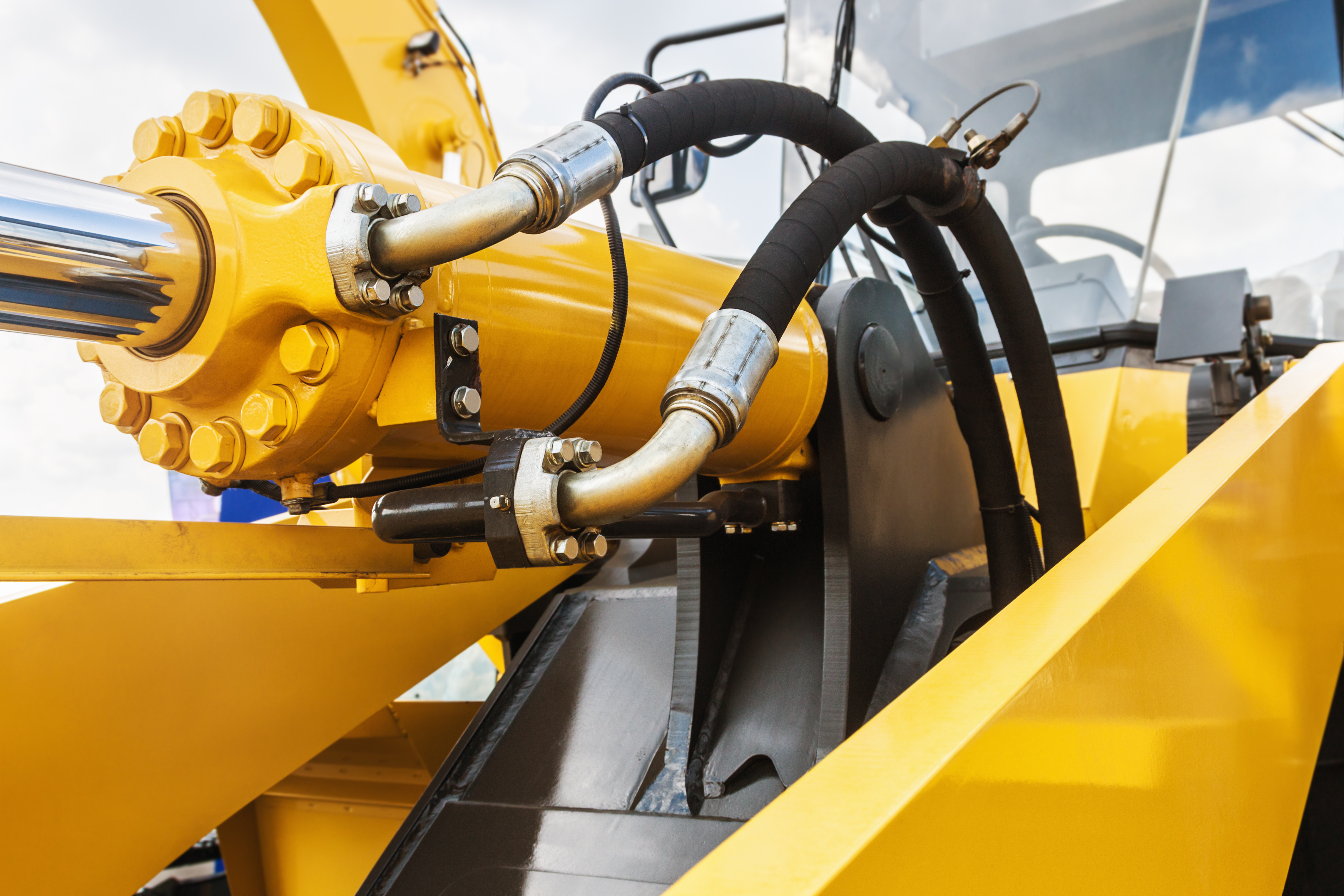Key Questions to Consider When Specifying a Hydraulic Cylinder
Choosing the best hydraulic cylinder for any given application is a detailed, straightforward process. Engineers and other specifiers can streamline the decision-making process by asking and receiving answers to these 9 questions:
1. What is the application?
Common cylinder applications include lifting, jacking, and pushing; pressing, pulling; lifting and lowering; lifting long distances; and holding the load. Industries that use large quantities of hydraulic cylinders are Food Production, Construction Equipment, Metals Fabrication, Agricultural Processing, Forestry, Mining, Lawn Care, and Waste Management.
2. How much space do you have to accommodate the cylinder?
.jpeg?width=398&height=265&name=Ligon%20Blog%20Post%20Photo%20%235%20(Construction%20Machinery).jpeg) The collapsed height of the cylinder will help you determine whether a particular cylinder is suitable for your application. If your application is in a low clearance environment, it is essential to choose a low-height cylinder.
The collapsed height of the cylinder will help you determine whether a particular cylinder is suitable for your application. If your application is in a low clearance environment, it is essential to choose a low-height cylinder.
3. What forces are involved in cylinder operation?
There are three sets of forces that a hydraulic cylinder can experience during operation: tension vs. compression, pressure, and rest vs. motion. Your application will dictate which type of force is most significant.
These 16 formulas can be useful in calculating the forces your hydraulic cylinder must withstand to operate most efficiently.
4. How much mass do you need to move?
.jpeg?width=372&height=248&name=Ligon%20Blog%20Post%20Photo%20%234%20(Trailer%20Lift).jpeg) The more accurate your estimate of the weight of the object you are moving, the better. If you are estimating weight, overestimate! You don’t want the lift to be a failure. You also don’t want to barely meet the load capacity of the cylinder, as any unexpected change or shift could cause the cylinder to stall in the middle of its cycle. Figuring out how much you are lifting is crucial in deciding which hydraulic cylinder to use.
The more accurate your estimate of the weight of the object you are moving, the better. If you are estimating weight, overestimate! You don’t want the lift to be a failure. You also don’t want to barely meet the load capacity of the cylinder, as any unexpected change or shift could cause the cylinder to stall in the middle of its cycle. Figuring out how much you are lifting is crucial in deciding which hydraulic cylinder to use.
Other considerations related to the load you want to move include:
Know your available pressure. The hydraulic pressure from your pump must be sufficient to provide enough pressure to act on the cylinder and lift the required load. The size of your cylinder won’t matter if you aren’t able to supply enough pressure.
Always build a safety factor into your calculations. Most loads are never exactly what they appear to be, and for safety’s sake, you would never want to be right at the limit of the cylinder’s capacity. Because of this consideration, it would be ideal if you used a cylinder that is 125% of the required load capacity. If possible, you should have a cylinder (or cylinders) that can handle a load 1.5x-2x larger than the load you are trying to lift.
5. What distance does the cylinder need to travel?
Telescopic cylinders are best for applications where more length is required. They are usually classified as 2-stage or 3-stage hydraulic cylinders and can be either single acting or double acting. Because their retracted lengths are no more than a regular hydraulic
cylinder, they’re also great for saving space in confined applications. Due to the surface area and size of the individual cylinders, the initial extension produces the most force. The more stages the telescopic cylinder has, the more force it can produce.
For applications requiring less length, traditional single acting and double acting cylinders are excellent choices. A single acting hydraulic cylinder operates in a single direction and refers to the action of the cylinder. It often has a single port and uses gravity or a spring to retract the plunger after it has been used.
In contrast, a double acting cylinder has two inputs. It uses hydraulics to push and pull the plunger, making it effective for applications in which rapid or controlled retraction is needed along with extension. Two single acting hydraulic cylinders could perform the same function, but one double acting cylinder is more cost-effective and is also a more efficient use of space.
6. Among Mineral Oils, Synthetic Oils, Water-Based Oils, and Biodegradable Oils, what kind of hydraulic fluid is best for any given application?
.jpeg?width=388&height=299&name=Ligon%20BLog%20Post%20Photo%20%236%20(Oil).jpeg) The short answer is it depends on the application. The long answer requires knowledge of numerous variables that make it impossible to generalize in this space. To acquaint you with each of those lubricant categories, here are brief descriptions of each type of oil.
The short answer is it depends on the application. The long answer requires knowledge of numerous variables that make it impossible to generalize in this space. To acquaint you with each of those lubricant categories, here are brief descriptions of each type of oil.
Mineral Oils
Mineral-based hydraulic oils are the backbone of the hydraulic industry. Originating from the refining process of crude oil, they've been the go-to choice for many hydraulic systems for decades. Their widespread popularity stems from their balanced performance metrics and cost-effectiveness. Mineral oils are versatile and can be used in many applications, from heavy machinery to industrial hydraulic equipment. They offer good lubrication properties, resistance to oxidation, and a decent temperature range. However, it's important to monitor them for signs of degradation, as contaminants can affect their performance over time.
Synthetic Oils
Synthetic oils come from meticulous engineering in state-of-the-art labs. Designed to cater to extreme conditions, these oils are perfect for environments that experience extremely high or extremely low temperatures. While synthetic oils have a higher price tag, their performance benefits often justify the investment. They offer superior viscosity stability, extended service life, and reduced wear and tear on hydraulic components. Plus, they can be tailored to specific applications to ensure that the hydraulic system gets the best possible lubrication and protection.
Water-Based Oils
In environments where safety is key, especially concerning fire hazards, water-based hydraulic fluids rise to the occasion. These oils have a significant amount of water to provide them with excellent fire-resistant properties. While they're safer in high-risk environments, they come with unique challenges. Water-based oils may not offer the same lubrication level as mineral or synthetic hydraulic oils which requires more frequent maintenance and checks. They may also be susceptible to microbial growth, so it's crucial to ensure that the system remains contamination-free.
Biodegradable Oils
As the world becomes more environmentally conscious, biodegradable hydraulic oils have carved a niche for themselves. These oils break down naturally when exposed to the environment, reducing the risk of long-term environmental damage in case of spillages. They're especially ideal for applications near water bodies or sensitive ecosystems. Biodegradable oils are formulated from natural sources like vegetable oils or synthetic esters. While they offer excellent performance and environmental benefits, they can be more expensive than traditional oils. Regular checks are also key to ensure they maintain their properties over time.
7. At what temperatures will the cylinder be used?
.jpeg?width=392&height=261&name=Ligon%20Blog%20Post%20Photo%20%233%20(Construction%20Truck).jpeg) Hydraulic cylinders function optimally at operating temperatures between 110°F and 180°F. If your cylinder is being used in cold conditions, it is important to compensate with a low viscosity oil, and if your cylinder is being used in a wet environment, particularly one containing salt water, it is critical for the cylinder to be protected from the elements to prevent or minimize oxidation or corrosion.
Hydraulic cylinders function optimally at operating temperatures between 110°F and 180°F. If your cylinder is being used in cold conditions, it is important to compensate with a low viscosity oil, and if your cylinder is being used in a wet environment, particularly one containing salt water, it is critical for the cylinder to be protected from the elements to prevent or minimize oxidation or corrosion.
8. How will the cylinder be mounted?
The way the cylinders are mounted will determine the amount of stress the pistons need to withstand.
The National Fluid Power Association has approved nearly a dozen cylinder mounting styles, including Foot Side lugs, Cap Rectangular Flange, Head Rectangular Flange, Head Square Flange, End Lugs, Centerline Lugs, Head Trunnion, Cap Trunnion, Intermediate Trunnion, and Cap Detachable Clevis. Those styles can be divided into three easy-to-remember categories: Fixed mounts that absorb force along the centerline of a cylinder, fixed mounts that do not absorb force along the centerline, and pivot mounts that drive a load in a curved path.
9. What specific requirements might the cylinder need to meet?
 Cushioning, synchronization, and sensing technology are three significant requirements a cylinder or cylinder system may need.
Cushioning, synchronization, and sensing technology are three significant requirements a cylinder or cylinder system may need.
Depending upon the application, hydraulic cylinders may need to meet specific requirements beyond the scope of a typical application. One such requirement is cushioning, or slowing the speed of the cylinder piston before it reaches the end caps. By decelerating the cylinder rod near the end of a stroke, the piston is prevented from striking the hydraulic cylinder ends and causing mechanical shock.
Additional benefits from deceleration include reduced noise and vibration, improved performance when moving heavy loads at high speeds, less cylinder maintenance, and extended operating life.
Synchronization is another requirement of an effective double acting cylinder or cylinder system. Without proper synchronization, the cylinders will move sporadically and out of sequence with one another rather than in unison. The best synchronization arrangements align the cylinders to operate in coordination with one another, which enables smooth and efficient system operation.
In high precision applications such as some types of manufacturing, such as food and chemicals production, it may be necessary to use sensors that take real-time readings of hydraulic process variables such as, position, pressure, flow rate, filling level, temperature, or contamination and transmit the data into a usable electrical signal.
To answer any questions that our responses may have prompted, or to discuss anything else related to the optimal use of hydraulic cylinders…




